Cocos (Keeling) Islands Travel Guide
Welcome to the taste2travel Cocos (Keeling) Islands Travel Guide!
Date Visited: March 2021
Introduction

The end of another day in paradise, as the sun sets on West Island, the main tourist hub of the Cocos (Keeling) Islands.
A remote, idyllic, Indian Ocean paradise, the Cocos (Keeling) Islands offer an exotic tropical island experience, far from the tourist hordes found elsewhere.
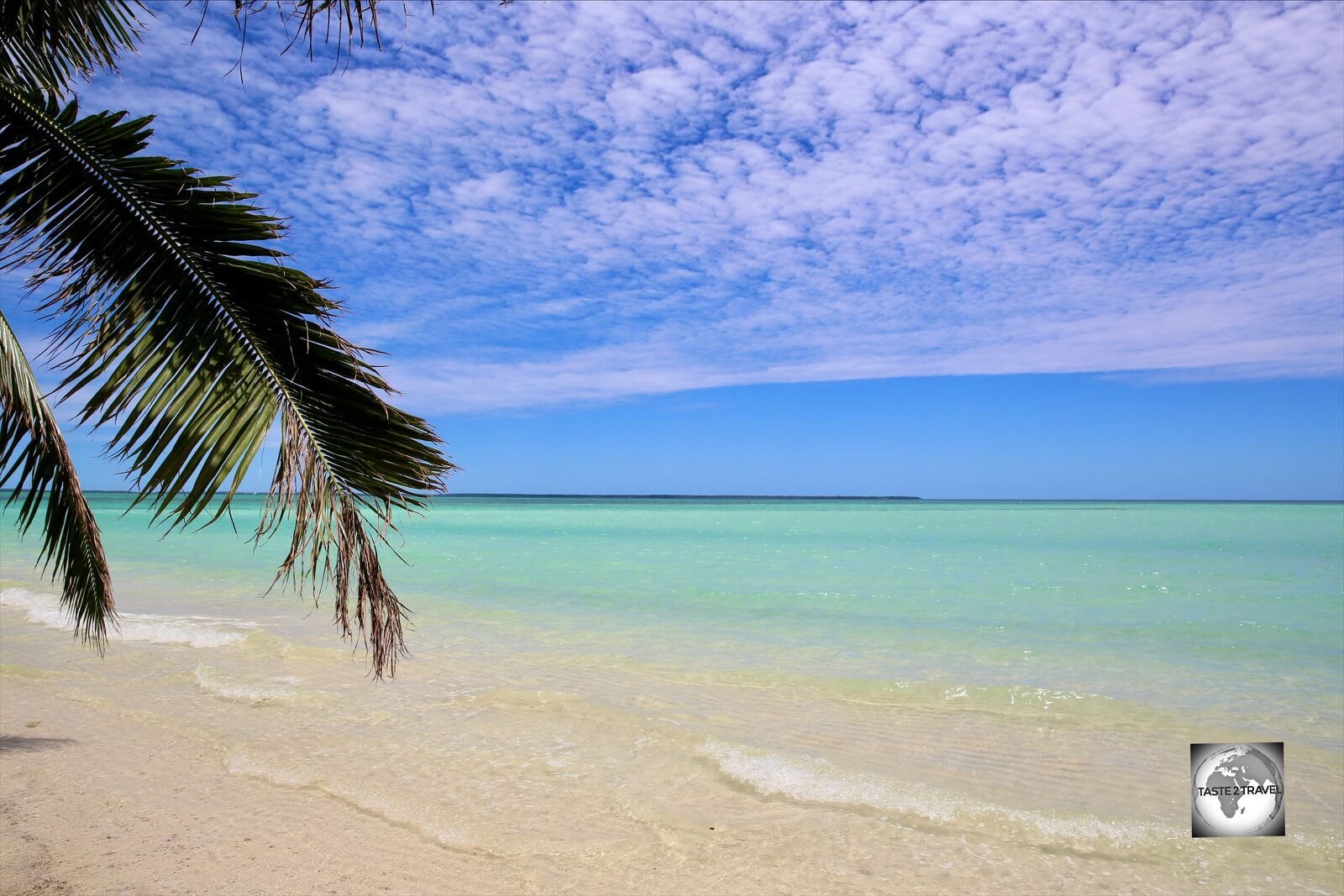
A typical lagoon-side beach on Home Island.
From picture-postcard, white-sand, beaches, which are lapped by the cleanest of warm, aquamarine water, Cocos, as it’s known to locals, is a beach-lover’s paradise.

A motorised canoe trip to the southern islands provides an opportunity to snorkel in the clear waters of the lagoon.
Beneath the surface, this remote atoll, which rises up from a depth of 5,000 metres, attracts an abundance of marine life which can viewed on a diving or snorkelling trip.
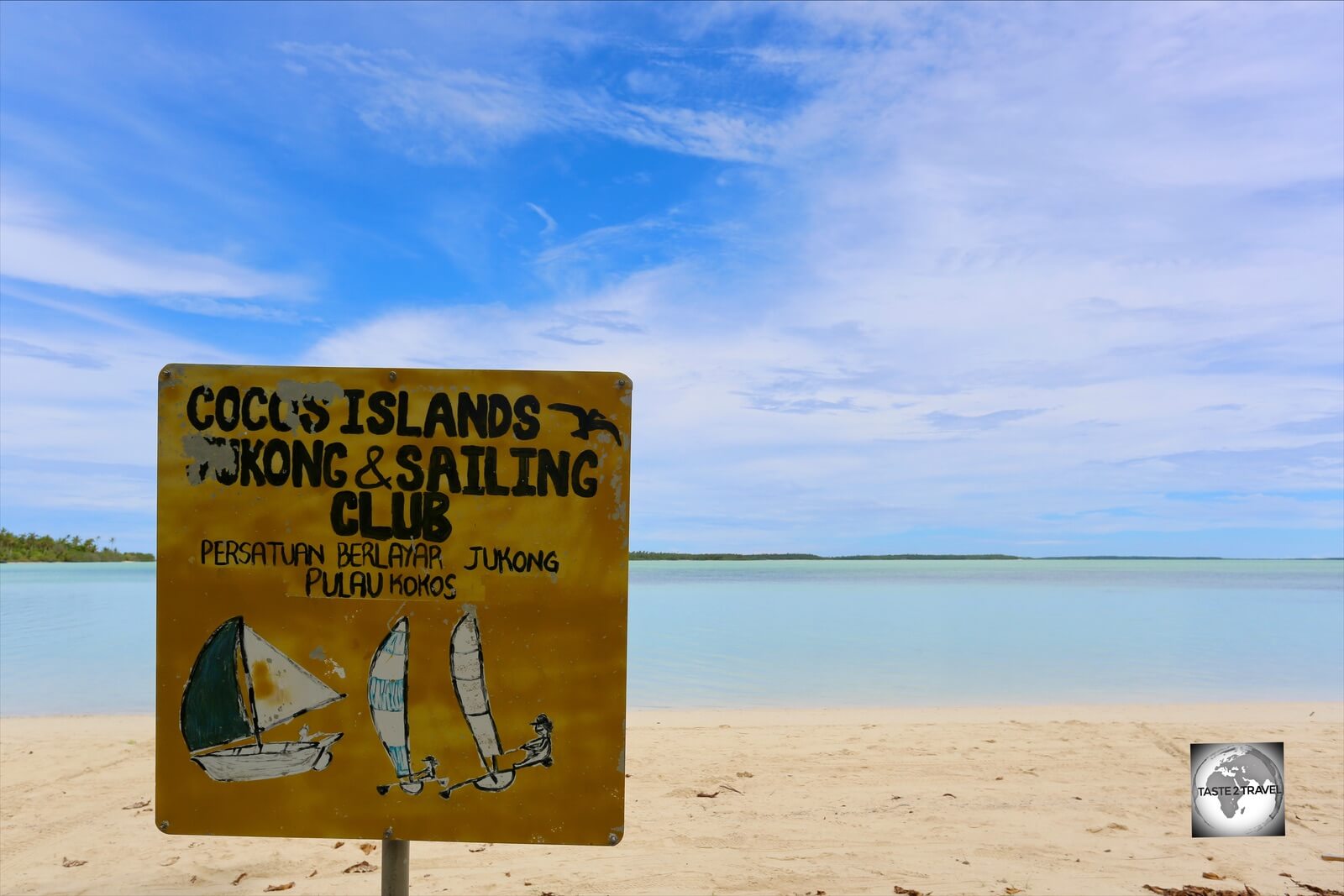
Sailing is an important recreational activity on this atoll territory.
An Indian Ocean atoll, which is a territory of Australia, Cocos (Keeling) Islands is comprised of 27 small barrier islands, with just two of the islands inhabited; West Island and Home Island.

A view of the lagoon from Home Island.
Of the islands, the sleepy and quiet Home Island is home to the Cocos Malay community while West Island is where most ex-pats live, and is home to almost all the tourist facilities and services on Cocos (Keeling) Islands, including the airport.
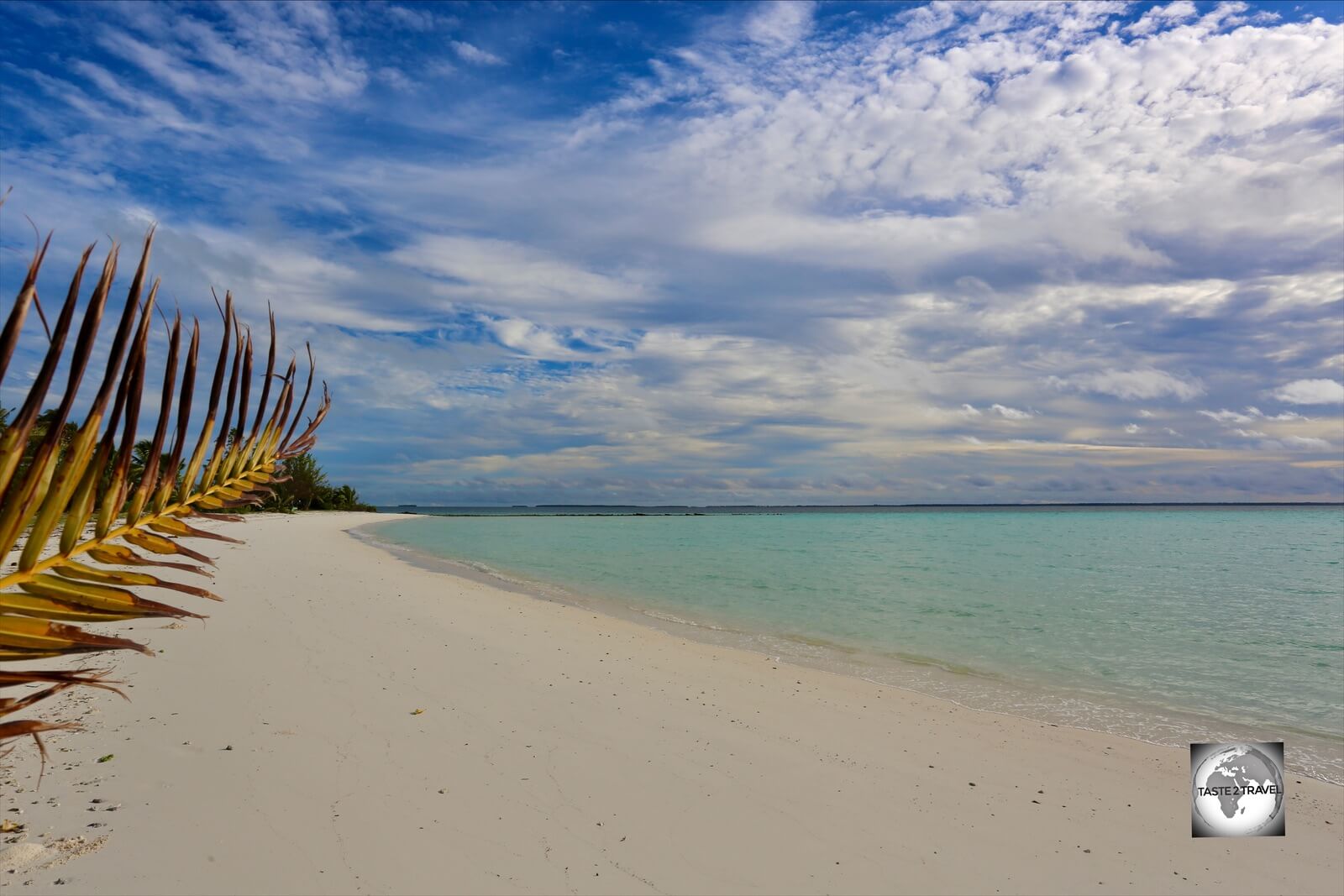
A view of Sandy Point beach, the finest stretch of sand on Home Island.
While the spectacular beauty of the Cocos (Keeling) Islands is the main tourist draw, with tourist brochures full of glossy images of picturesque beaches, the islands are home to a captivating history which centres around the Clunies-Ross family.

“Cocos (Keeling) Islands blues.”
For 150 years, the Clunies-Ross family ruled the islands as a private fiefdom, operating a large coconut plantation which produced Copra for the export market.

The frontrunners in the monthly Jukong race on Home Island.
To operate the plantation, the Clunies-Ross family imported indentured labourers, mostly from Malaysia and Indonesia.
Having existed in isolation for most of the past 150 years, this Cocos Malay community have created their own, unique, culture, one which they are happy to share with visitors.

One of four guest rooms at Oceania House, the George room is named after George Clunies-Ross, the designer and builder of Oceania House.
For something truly special, the former mansion of the Clunies-Ross family, Oceania House, is now operated as a guest house, offering four, beautifully furnished, guest rooms.
If you wish to learn about the history of the island, the Clunies-Ross family, and understand the story of Cocos, this is, absolutely, the place to stay (refer to the ‘Accommodation‘ section below for more details).

Sunset over the Indian Ocean, as seen from the beach on West Island.
During my stay, I split my time between West and Home Islands and was glad I did. The two islands offer two very different travel experiences. Most tourists stay only on West Island, travelling to Home Island on a daytrip.

Sandy Point is the finest beach on Home Island.
An ‘overseas’ territory, the Cocos (Keeling) Islands are currently experiencing a tourism boom, with Australians, who are unable to travel internationally due to the Covid pandemic, looking for alternative holiday destinations.

A White-tailed tropicbird flying over Home Island.
Historically, the islands have been a tourism backwater, far off the beaten track and very expensive! Due to this, tourism infrastructure is limited with just 149 beds on the island and two flights per week connecting the territory to Perth.
Currently, Cocos is operating at full capacity, with the biggest challenge being finding accommodation.

A Horn-eyed ghost crab on South Island.
Despite the current capacity issues, the Cocos (Keeling) Islands are a charming and rewarding destination with much to offer those willing to make the 3,000-km journey from Perth.
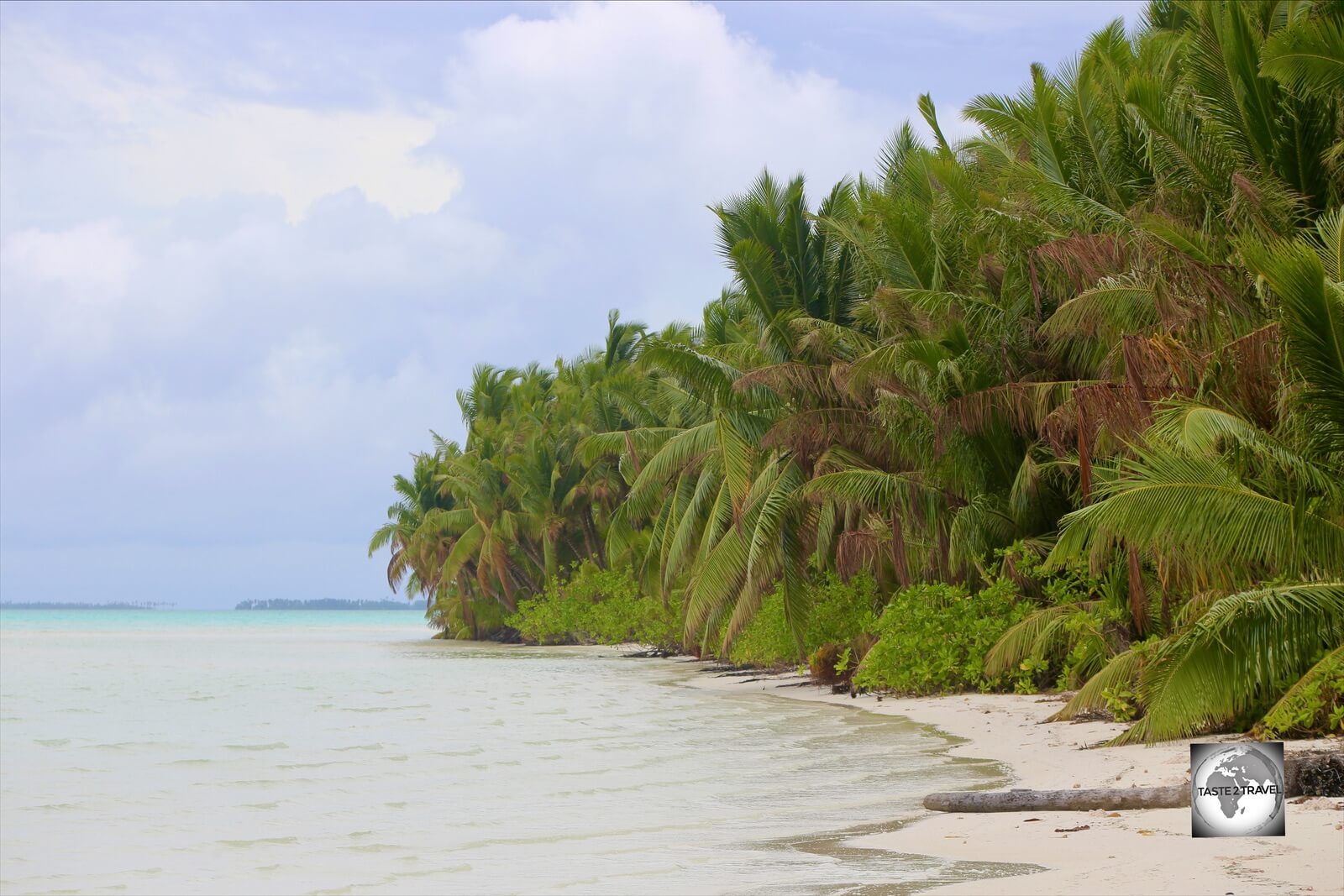
A beach on the lagoon side of West Island.
Location
Bantam Shire of Cocos 6799, Cocos (Keeling) Islands
An Indian Ocean territory of Australia, the Cocos (Keeling) Islands are an atoll, located 2,936 kilometres north-west of Perth; 986 kilometres south-west of Christmas Island; 1,270 kilometres south-west of Jakarta (Indonesia) and 2,834 kilometres south-east of Colombo (Sri Lanka). The nearest landmass to the south is Antarctica, which is 6,100 kilometres due south.

A beautiful Indian Ocean sunset on West Island, Cocos (Keeling) Islands.
Formed on top of an ancient volcanic seamount that rises from a depth of 5,000 metres, Cocos (Keeling) Islands is comprised of 27 small, coral islands with a total land area of approximately 15.6 square kilometres.
The most northerly island, Keeling Island, is a restricted national park which is home to nesting sea birds and the wreck of the Germany warship, the SMS Emden.
Charles Darwin: Theory of Atoll Formation

A hand-painted map of the Cocos (Keeling) Islands, showing the circular shape of the barrier islands.
During his epic voyage on the HMS Beagle, Charles Darwin charted reef systems around the world. It was in 1836 that Darwin visited the Cocos (Keeling) Islands, and, after surveying the islands, formed his theory of atoll formation.
In Darwin’s theory, he proposed corals first form a fringing reef around the shores of a volcano. As the volcano collapses and erodes, the fringing reef remains, with corals building up over time, eventually forming a series of circular barrier islands.
At the time it was proposed, his theory was ridiculed. It wasn’t until the end of the 19th century, when researchers performed an experiment on the remote Pacific atoll nation of Tuvalu, was Darwin’s theory proven to be correct.
The experiment, which took place between 1896 and 1898, involved researchers from the Royal Society of London and an Australian geologist, Sir T.W. Edgeworth David, a Welsh-born Australian geologist from the University of Sydney.
The aim of the experiment was to drill a bore hole deep into Tuvalu to determine whether the atoll was formed over a volcano. Over the course of three separate expeditions, the scientists were able to drill to a depth of 340 metres (1,1154 ft) at which point they encountered volcanic material, proving Darwin’s theory to be correct.
The place where this significant experiment took place is today marked by a very unceremonious white PVC pipe which sticks out of the footpath in a suburban street in Funafuti (click here to read my Tuvalu Travel Guide and to see a photo of the PVC pipe).
Fresh Water Supply

An old well on Home Island shows the shallow depth of the fresh water lens.
One characteristic of an atoll is that any rainwater which falls seeps through the sandy soil into a subterranean fresh water reservoir, known as a lens. Due to fresh water being lighter than salt water, this “lens” floats above the seawater below.
The tap water on Cocos is drawn from this lens and is some of the freshest and purest drinking water in the world. It was baffling to see that supermarkets were selling imported, bottled water.
Traditionally, fresh water on Cocos was drawn from the lens through wells, many of which can still be seen on Home Island. Located just a couple of metres below ground, the lens is approximately 60 cm in depth.
Today, the Australian government has installed a series of pumps which extract the fresh water. This is then filtered, before being piped to each household. It tastes amazing!
All of this could be under threat! The porous structure of an atoll means that any sea level rise, resulting from climate change, will have a devastating effect on this fresh water supply.
The coral substructure of atolls naturally allows seawater to permeate. Should the salt water level rise, it is conceivable that the sea will push the fresh water lens above the surface, so that instead of being protected underground, freshwater sources become a series of polluted, fetid puddles.
History

Now housed in the Home Island museum, this bust of John Clunies-Ross used to reside in the library at Oceania House.
Uninhabited and undisturbed for most of its history, the remote Cocos (Keeling) Islands were first discovered in 1609 by the British sea captain William Keeling, who passed by without laying any claim to the islands.
The islands remained in obscurity until the early 19th century when, in 1825, Scottish merchant seaman Captain John Clunies-Ross stopped briefly at the islands while sailing to India on the ship Borneo. In true English style, he nailed a Union Jack to a tree! He also decided to return to this idyllic paradise and settle on the islands with his family.
One year later, in 1826, Alexander Hare, a British merchant, and infamous polygamous, had also decided to settle on the Cocos (Keeling) Islands where he would live with his harem. Hare, who lived on Borneo, had been given a royal title and was known as the “English White Rajah of Borneo“.

A former coconut plantation on Home Island.
Hare hired Robert Clunies-Ross (brother of John) to carry him, a team of indentured labourers and a volunteer harem of 40 Malay women to the islands, where he hoped to establish his private residence and live happily ever after in a hedonistic tropical paradise.
As can be expected from a polygamous, he placed the men on Home Island and the women on Prison Island. The only person happy with this arrangement was Hare!
The following year, in 1827, John Clunies-Ross arrived on the islands with his family and eight sailors and settled on Pulu Gangsa (now the site of the cemetery and now part of Home Island.) Due to tensions with Hare, Clunies-Ross moved to neighbouring South Island.

This abandoned warehouse on the Clunies-Ross estate was formerly used to store Copra until an export ship arrived, which was once every 6 months.
In 1829, Hare exported the first coconut oil to England aboard the Borneo. At this time there were 98 Malays living on the island.
In time, a feud between Hare and Ross escalated and, by 1831, Hare decided to leave the islands for Batavia (modern day Jakarta). He later settled in Bencoolen (on the south coast of Sumatra), where he died in 1834.
The Clunies-Ross family then took control of the islands and ruled them as a private fiefdom for almost 150 years from 1827 to 1978.
The patriarchs of the family styled themselves as “kings” and were called Ross I (John Clunies Ross 1786–1854), Ross II (John George Clunies-Ross II 1823–1871), Ross III (George Clunies-Ross III 1842–1910), Ross IV (John Sydney Clunies-Ross IV 1868–1944), Ross V (John Cecil Clunies-Ross (1928–).
Meanwhile, in 1857, a Monty Python-esque historical event involved the arrival of Captain Fremantle on the HM Juno who had been instructed to “go and annex the Cocos Islands in the name of Her Majesty“.
He arrived on the islands, carrying a wooden proclamation sign, declaring the Cocos Islands for Her Majesty. The only problem – he was in the wrong place! He was supposed to annex the Cocos Islands in the Andaman Group.

Dating from 1857, this wooden proclamation sign, which is today displayed in the museum on Home Island, declares the ‘Cocos Islands’ as a British territory.
The proclamation sign, which was once kept at Oceania House, is today housed in the Home Island museum. Due to this mistake, John George Clunies-Ross was designated as governor of Cocos.
What’s in a name?
This confusing event explains why the islands today are named Cocos (Keeling) Islands. It avoids confusion with the other places around the world which are called “Cocos Islands”.
The islands have had various names over the years, having been known as Cocos Islands, the Keeling Islands, the Cocos–Keeling Islands and the Keeling–Cocos Islands.
The territory’s Malay name is Pulu Kokos (Keeling).
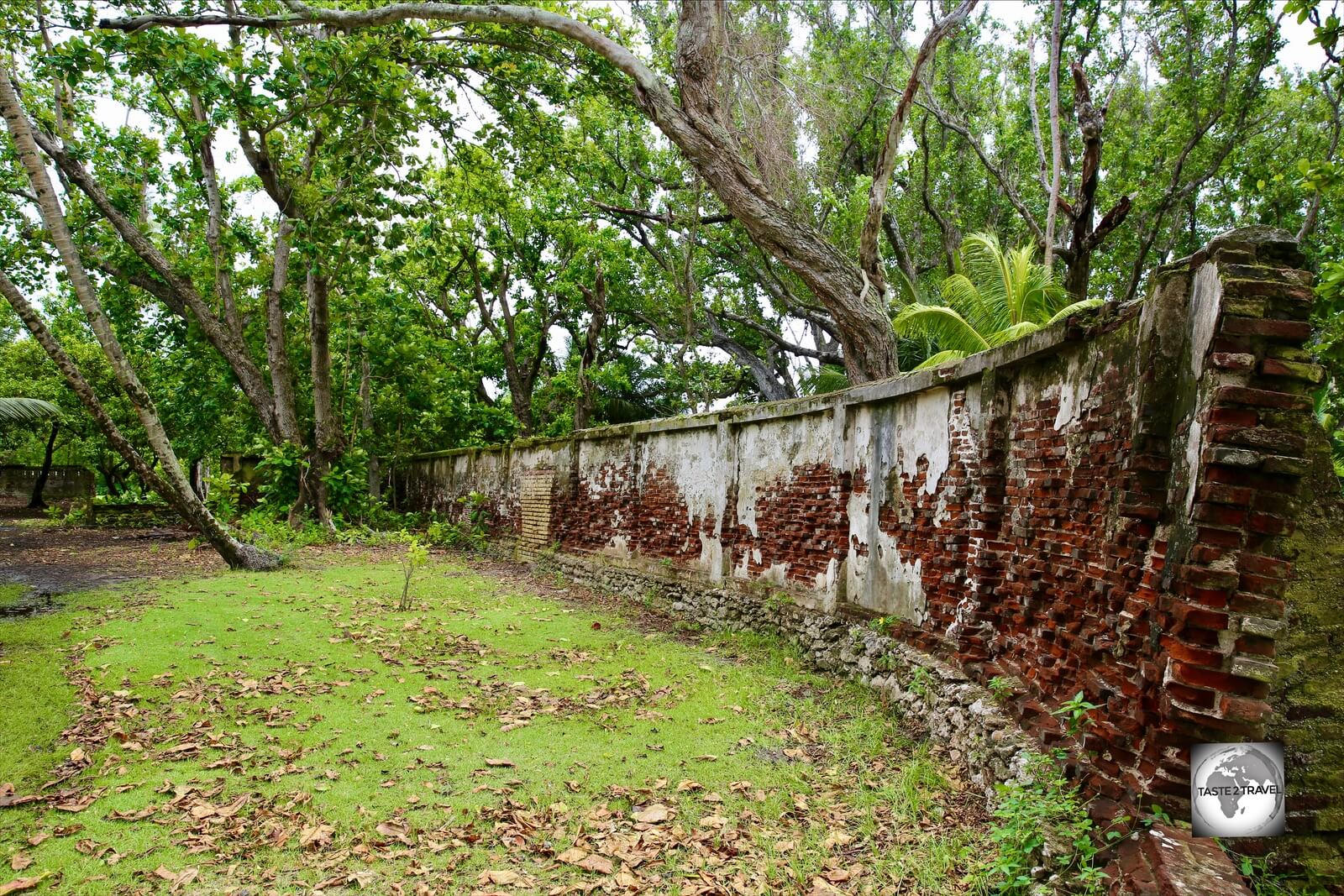
The crumbling brick walls which surround the Clunies-Ross estate on Home Island.
In 1886 Queen Victoria granted ownership of the Islands to the Clunies-Ross family for perpetuity. The following year, in 1887, George Clunies-Ross built an estate which he called Oceania, which was set on 12 acres of garden, overlooking the lagoon on Home Island.
The centrepiece of the estate is the 2-storey Oceania House which today is a guest house (see the ‘Accommodation‘ section for more details).
Cocos Rupee

The early sheepskin version of the Cocos Rupee, on display at the Home Island museum.
With which currency does a family operating an isolated fiefdom pay its workers? Its own, home-made, currency of course!
During their rule, the Clunies-Ross family paid their Cocos Malay workers with the Cocos Rupee, a private currency, which was redeemable only at the family-owned, company store on Home Island.
This closed monetary system was especially frustrating for the locals, especially when the occasional trading boat visited the islands and the locals, not possessing any exchangeable currency, were unable to purchase goods.
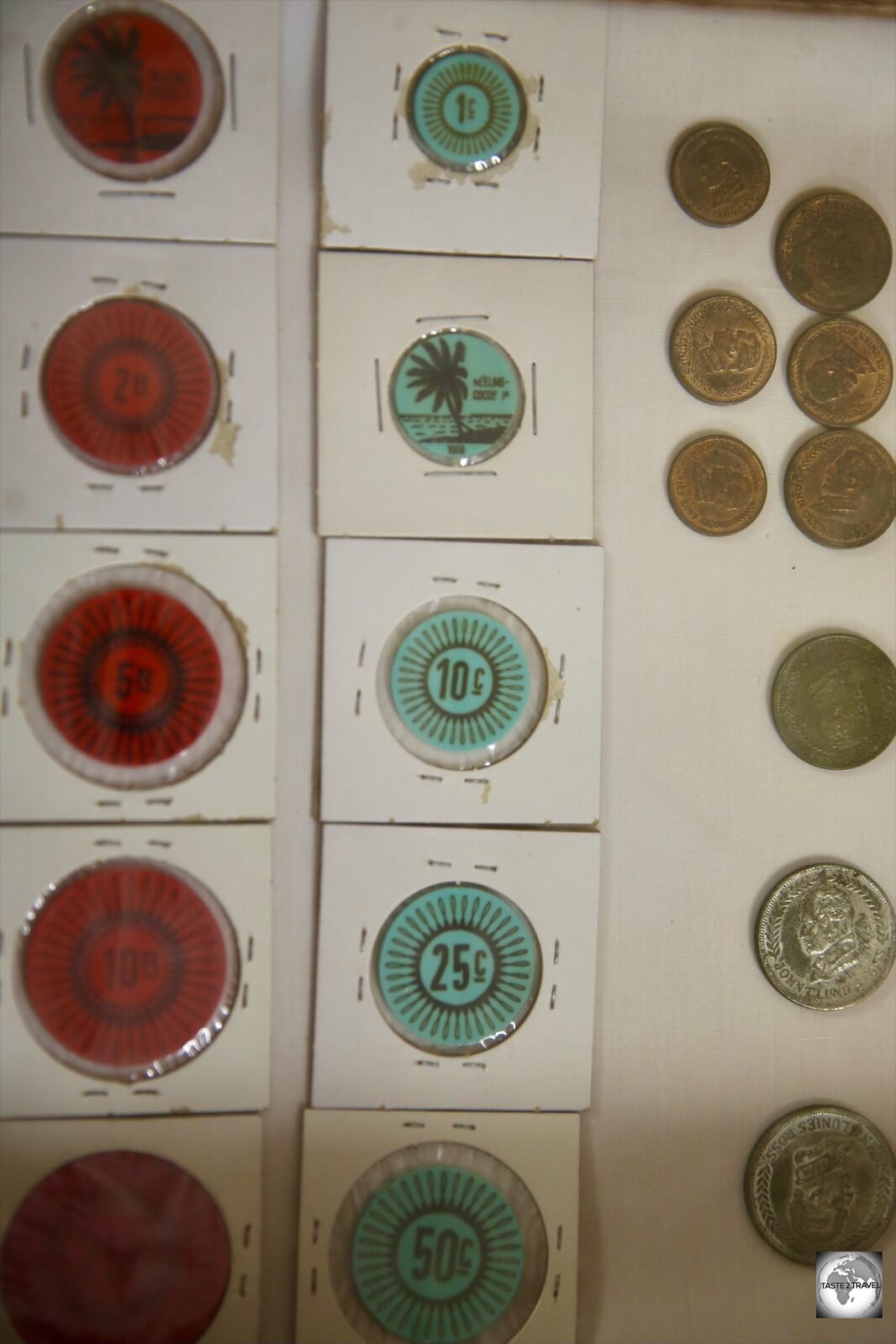
The modern version of the Cocos Rupee was in the form of coloured plastic tokens.
The Cocos Rupee was first issued in 1879 on sheepskin, and bore the signature of George Clunies-Ross. There were 100 cents to every 1 Rupee.
The Clunies-Ross family kept a close eye on all released and circulated currency with six denominations in circulation – 5, 3, 2, 1, ½, and ¼ Rupee. Later, in 1902, Ross IV introduced the 1/10 Rupee and dispensed with the 3 Rupee.
Later versions of the currency were released on Ivory tokens and then, in the 1960’s as plastic tokens. The machine which made these plastic tokens is on display in the Home Island museum.
Today, you can view a selection of currency at the Home Island museum.

The former Clunies-Ross company store on Home Island, which today serves as the islands’ gym.
In 1955, the Cocos (Keeling) Islands were transferred from British to Australian control, although the Clunies-Ross family continued to operate the island as a fiefdom.
By the 1970’s, the Australian government had become dissatisfied with the family’s feudal style of rule. The issue of an indentured labour force being paid in a private currency didn’t help matters.
In 1978, Australia forced the family to sell the islands for the sum of A$6,250,000, using the threat of compulsory acquisition. By agreement, the family retained ownership of Oceania House.
Cocos Islands Cooperative Society
Following the removal of the Clunies-Ross family in 1978, the Cocos Islands Cooperative Society was formed, which allowed the local Cocos Malays to acquire the business operations of the Clunies-Ross estate. The Cocos Malays are members of this co-op, with members electing a board of 8 directors who serve three year terms.
The co-op has interests in retail, hospitality and logistics.
Involved in many aspects of island life, the co-op owns the supermarket on West Island, the hardware store on Home Island, the only inter-island ferry, the one public bus on West Island, the Cocos Beach Resort, the Tropika restaurant and more.
The co-op is also responsible for the operation of the airport.
Breadfruit

Breadfruit growing on Home Island.
It was interesting, but not surprising, to see Breadfruit growing on Home Island.
The story of British involvement with Breadfruit is fascinating and starts with Captain James Cook, who first discovered it on Tahiti (French Polynesia) where he referred to it as ‘bread growing on a tree’.
Upon his return to England, he reported its existence to the King of England, who decided that a starchy staple that grows on a tree would be ideal to feed a growing slave population in the Caribbean.
The King then commissioned Captain William Bligh to sail the HMS Bounty to Tahiti, to collect, then transplant, 150 young breadfruit trees to the Caribbean.
This journey ended abruptly, off the coast of Tonga, when Fletcher Christian and crew staged their Mutiny on the Bounty! The mutineers settled on Pitcairn Island, which they eventually outgrew. Queen Victoria then granted them Norfolk Island as a new, much bigger, island home.
Meanwhile, after rowing 6,500 kilometres west, across the Pacific Ocean, in a small row boat, Captain Bligh reached Batavia (Jakarta) where he then hitched a ride back to England.
Determined as ever, Bligh set sail again for Tahiti, collected a new batch of breadfruit trees, then transported them to the Caribbean, where they were planted on various British-controlled islands.
Today, Breadfruit is a staple of the Caribbean diet and forms an integral part of Jamaican BBQ. One of the original breadfruit trees, which was planted by Bligh, can be seen today in the Kingstown Botanical Garden, in the capital of Saint Vincent and the Grenadines!
The British eventually transported breadfruit around the world, planting it in those tropical areas where it could grow, providing a valuable food source for young colonies and settlements.
The story of the dispersal of breadfruit from its native Tahiti is a global one, and has been included in many of my Travel Guides. I have included links (above) to those reports which contain mentions of the breadfruit story.
People

Two Cocos Malay girls, enjoying some strawberry milk, on Home Island.
Due to its isolated location, the Cocos (Keeling) Islands remained uninhabited until 1826 when the first settlers were bought to the island by the English merchant Alexander Hare.
Today referred to as Cocos Malays, these first settlers were drawn from various parts of South-east Asia, including modern day Malaysia and Indonesia.

A family of Cocos Malays on Home Island harvesting coconut meat for an upcoming wedding feast.
Over generations, the Cocos Malay have developed their own unique culture and identity, based on the customs of their Malay ancestors, mixed with aspects of Islam and some European practices.
At the core of this identity lies strong family values and a firm belief in Islam, which is practiced by 75% of the population (as per the 2016 census).
While younger Cocos Malays speak English, many older Cocos Malays only speak Malay (Bahasa). Knowing a few words of Malay can help with interactions, especially on the more traditional Home Island.
While clinging to their traditional culture and identity, the younger generation of Cocos Malays are as much at home on the islands as they are on the Australian mainland, where they spend time in modern, cosmopolitan, metropolises, such as Perth, finishing secondary school, attending tertiary institutions and developing careers, friendships and lives.
As I ate my breakfast each morning at the Island Brunch cafe on Home Island, a steady stream of young locals would cruise in on their buggies, ready to order a pancake stack, a cappuccino, café latte or a babyccino for their kids.
Wildlife
Typical of a remote atoll, there are very few endemic species on Cocos (Keeling) Islands. The most northern island, Keeling Island, is designated as a national park – the Pulu Keeling National Park – which is managed by the Australian National Parks. The island, which is off-limits to visitors, is home to a seabird rookery and is the site of the wreck of the SMS Emden.
Birds
Of the land species, migratory seabirds are common. As on other tropical islands, terns, boobies, noddies, frigatebirds and white-tailed tropicbirds can be seen in abundance.

White terns on South Island.

A Brown noddy on South Island.

A Pacific reef heron on Home Island.
Crabs
Cocos (Keeling) Islands is home to an abundance of crabs, with one of the funkiest being the Horn-eyed ghost crab, which is easily distinguished by its “horns” which protrude from the top of its eyestalks.

A Cocos Purple land crab on West Island.
Unlike neighbouring Christmas Island, where the not-so-shy Christmas Island red crab can easily be photographed, the Cocos Purple land crab is much more skittish, often fleeing into their burrows before you get anywhere near them.

A curious crab on Home Island.
Three species of hermit crabs appear in large numbers throughout the atoll with the smaller, Red hermit crab, outnumbering the larger Purple hermit crab and Tawny hermit crab.

A Red hermit crab on South Island.
Reptiles

A Mourning gecko on Home Island.
The only reptiles on the atoll are three species of geckos which have been introduced, the Mourning gecko; Four-clawed gecko and the House gecko.

A House gecko on Home Island.
If you have an interest in photographing the geckos of Cocos (Keeling) Islands, you can find them basking in the sun on the Home Island ‘Welcome’ sign, opposite the ferry dock.
Flag

The flag of Cocos (Keeling) Islands.
How often does a teenager get to design a national flag? In 2003, Mohammed Minkom, a local teenager, won a design contest for a new flag which was then adopted on 6 April 2004.

The flag of Cocos (Keeling) Islands flying on Home Island.
The flag consists of a green field, with a palm tree on a gold disc on the hoist side; a gold crescent moon in the centre of the flag and a gold southern cross on the fly side. The colours used are the Australian national colours – green and gold.

Souvenir flags of Cocos (Keeling) Islands.
The palm tree represents the islands’ tropical flora and the history of the atoll as a centre for the production of copra, while the crescent represents Islam, the religion of the Cocos Malays who make up a majority of the islands’ population.
The Southern Cross, a constellation which is clearly visible in the night sky, appears on many flags throughout the Southern Hemisphere.
Currency

The Australian dollar is the official currency of the Cocos (Keeling) Islands.
The official currency of the Cocos (Keeling) Islands is the Australian dollar (A$), which trades under the international currency code of AUD.
Having the distinction of being the world’s first polymer currency, the dollar is issued in bank notes of $5, $10, $20, $50 and $100 and is divided into 100 cents (c), with coins being issued in denominations of 5c, 10c, 20c and 50c, $1 and $2.
All bank notes are printing in Melbourne by Note Printing Australia (a division of the Reserve Bank of Australia), who also print polymer bank notes for Central banks around the globe.
Like mainland Australia, most transactions on Cocos (Keeling) Islands are cashless with credit cards being widely accepted.
To check the current exchange rate between the Australian dollar and the US dollar, click here.
Banking Services
There are no banks on Cocos (Keeling) Islands but cards can be used at the post office to withdraw cash from Australian banks.
Costs
Not cheap!
I met few budget travellers on Cocos (Keeling) Islands, and, local tourism operators told me that they have no desire to attract the cheap and cheery holiday crowd. The island has limited capacity for tourists, with higher spending visitors being the target market.
Considering its isolated location, and the fact that everything is freighted in, costs are not totally outrageous with airfreight adding about $9 per kilo to everything.
The two major expenses are flights and accommodation.
Some sample costs:
- Return Virgin Australia airfare to Cocos (Keeling) Islands from Perth: $A910 (US$705)
- Room (per night) at The Breakers (formerly Cocos Village Bungalows) on West Island: A$265 (US$205)
- Room (per night) at Oceania House on Home Island: A$250 (US$194)
- Park Suite (per night) at the Cocos Beach Resort: A$195 (US$150)
- Motorised Canoe Excursion with Cocos Islands Adventure Tours: A$130 (US$100)
- Cappuccino, Café latte: $A5 (US$3.90)
- Bottle of beer at the Cocos Club: $A6 (US$4.65)
- Bacon and eggs breakfast at Saltmakers: A$19 (US$14.70)
- Chicken Parmigiana dinner at the Cocos Club: $A25 (US$19.35)
- Local bus to the ferry wharf on West Island: $A0.50 cents (US$0.40)
- Ferry between West Island and Home Island: A$2.50 (US$1.95)
Philately

The Red-Footed Booby stamp, one of the newer stamp issues from Cocos (Keeling) Islands.
Overseas philatelic subscriptions use to keep a handful of staff at the Cocos (Keeling) post office busy, with about 3,000 standing orders being processed every time a new issue was released.
Today, stamps can be purchased online from the Australia Post website, although issues have been reduced, with typically just two new issues released each year.

The ‘Garden Fruits of Cocos’ stamp issue shows four exotic fruits which have been introduced to the islands.
Staff at the post office on West Island reflected nostalgically on the good old days, when many more issues were released each year and the island had its own philatelic bureau.
You can purchase stamps from the friendly staff at the West Island and Home Island post offices.
Sightseeing
West Island

The sunset view from Saltmakers by the Sea on West Island.
West Island (population: 140) is the gateway and main tourist hub of the Cocos (Keeling) Islands and home to the small Cocos ex-pat community.
Everything is centred around the airport, with the Cocos Keeling Visitor Centre, Post Office, Supermarket and the few dining options within a few steps of the terminal building.
When flights arrive, accommodation providers greet their guests outside the arrivals area, then walk them to their bungalows. It’s all very casual and relaxed with even the local police welcoming visitors to the island in their uniform of shorts and reef shoes.

The sunset view from West Island.
The one main road, which runs the 15-km length of the island, provides access to all the places of interest. You have the option of exploring the island using a rental car, bicycle, scooter or on foot. While the island can be explored in a few short hours, it makes for a good base to explore the other islands of the atoll.
If you wish to partake in any activities such as diving, motorised canoe trips, snorkelling, fishing trips etc, you will need to be staying on West Island, since all of these activities depart from the island.
In the north of the island, Trannie’s beach is a protected swimming beach on the exposed, ocean side of the island. On the lagoon side, there are many ideal swimming beaches where the water is much calmer, while in the south, Scout’s park is home to a beautiful beach.
Scuba Diving
The abundant marine life on Cocos (Keeling) Islands is diverse and plentiful and easily observed on either a snorkelling or diving trip.
Dive trips can be organised by contacting the island’s dive master – Dieter Gerhard at scuba@cocosdive.com
South Island

Cruising around the southern islands of the atoll in my motorised canoe.
One of the highlights of my trip to Cocos was a Motorised Canoe tour which was conducted by Ash and Kylie James, the friendly and enthusiastic owners of Cocos Islands Adventure Tours. The tours are very popular, with advanced reservations recommended.
As part of their business, which is run out of their beachfront home, Kylie and Ash offer car hire, a bus tour of West hour, kayak and canoe rental plus much more. They have both worked in a variety of roles on the islands over the years and, as such, are a wealth of information.
Once you’ve completed their motorised canoe tour, you’re able to rent one of the canoes yourself.

Our colourful motorised canoes at South Island.
Despite the fact that a pesky tropical depression was hanging over the island, and that it poured rain the whole evening before our tour, we still departed early in the morning.

The uninhabited South Island is the southernmost and easternmost island of the Cocos (Keeling) Islands.
We were eventually rewarded for our determination with the skies clearing in time for a magnificent snorkel through a channel which was brimming with marine life, including turtles and two black-tip reef sharks.

A view of the lagoon from South Island.
Ash, who has a clear love of the islands, is an entertaining and animated host. The tour started with breakfast on a remote beach. Sparkling wine, croissants, cheese, salmon, muffins and more.

Red hermit crabs on South Island, competing with the much larger Purple hermit crabs for food scraps.
Any food scraps were fed to the multitude of hermit crabs who inhabited the beach. After breakfast we each selected a Hermit crab for the inaugural South Island Hermit Crab race, with the winning crab being the first one to make it beyond the outer perimeter.

After breakfast on South Island, it was time for a hermit crab race.
While on South Island, we climbed a slight slope to reach the highest point on the Cocos (Keeling) islands which is located at 9-metres above sea level. The high point is covered with an old concrete slab, which once served as the floor of a military installation.

At 9-metres (30 ft) above sea level, this concrete platform on South Island, marks the highest point on the Cocos (Keeling) Islands.
Home Island

The Home Island ‘Welcome’ sign.
Located a short ferry ride across the lagoon from West Island, but a world away, Home Island (population: 450) is home to the small Cocos Malay community who live in the sleepy village of Bantam. This traditional community is home to a mosque, two cafes, one supermarket and a post office.
Home Island has been the centre of Cocos life since the first settlement was established in 1825. One of the highlights of the island is the small Home Island Museum, which is always locked, but can be accessed by asking for the key from the receptionist in the adjacent Cocos Shire building.
The island has a relaxed, chilled atmosphere with the silence only being broken by the call to pray which is broadcast five times each day from the mosque.
While many of the elderly Cocos Malays do not speak English, the young Cocos Malay, who travel to Perth to complete high school, are fluent in English, speaking it with a distinct Aussie twang.
I spent four nights at Oceania House (see the ‘Accommodation’ section for details) where I was the only guest. The only other tourists I saw on the island were day-trippers from West Island.
Home Island Buggies

The buggies of Home Island.
At less than 1 square kilometre in area, the island is easily covered on foot. Locals drive golf buggies rather than cars with a full range of buggies plying the streets of the island.
If you wish to hire a buggy, you can do so through Home Island Hire.

The buggies of Home Island.
Home Island Museum

Wayang Kulit puppets adorn the doors of the Home Island Museum.
Despite its small size, the Home Island museum includes a broad range of engaging displays which cover various aspects of Cocos life, from the culture of the Cocos Malays, the rule of the Clunies-Ross family, the local fauna and flora and naval war history, including the sinking of the SMS Emden during WWI.

Displays at the Home Island Museum.
Located a short stroll from the ferry jetty, the museum is open Monday to Friday during Shire office hours.

The Sungguh Juga Jukong at the Cocos museum on Home Island.
The key for the museum can be obtained from the receptionist in the blue Cocos Shire building which is located behind the museum.

A traditional wooden Jukong at the Cocos museum on Home Island.
Apart from displays in one small room, the grounds of the museum contain maritime displays such as traditional wooden boats and a shed full of nicely painted Jukong’s.

One of the many artefacts from the Clunies-Ross family which are displayed at the Home Island museum.
Perhaps not surprising, one of the main subjects covered by the museum is the Clunies-Ross era. If you wish to gain some insight into the way they ruled the islands, the museum (and Oceania House) are the two must visit places.

A bust of George Clunies-Ross, displayed at the Home Island museum.
Displays include family artefacts, five busts of the different ‘kings’ of Cocos, a selection of the Clunies-Ross currency (including the machine which was used to manufacture the plastic token currency in the 1960’s) and much more.

Made of teak, the very fine G.C.R. boat was designed in 1911 by George Clunies-Ross and is based on a design from the Shetland Islands.
One of my favourite items was a very finely crafted teak boat which was designed and built by George Clunies-Ross in 1911 and is apparently based on a design from the Shetland Islands, the birthplace of John Clunies-Ross.

An abandoned oven, which was once used for drying coconuts.
The grounds of the museum include a shed which houses an old oven, which was one used to dry coconuts.
This shed, like others in the vicinity of the museum, house many beautifully restored Jukong boats.
Jukong Boats

Jukong wooden boats at the Home Island Museum.
The iconic Jukong boat is a common sight on Home Island and in important part of the Cocos Malay culture.
It was especially useful that John Clunies-Ross was a shipwright, since the only way to transport coconuts from the outlying islands, back to Home Island for processing, was with small boats which could easily navigate the shallow waters of the lagoon.
He developed the Jukong which served as the workhorse of the Cocos Islands’ coconut oil industry. Home Island is home to a large collection of these finely crafted boats, with many on display at the Home Island Museum.
Jukong Race
Once a month, locals from the Cocos Islands’ Jukong and Sailing Club race their Jukong’s in the lagoon off Home Island.
I was fortunate to be on the island on race day and have included some photos here.

All Jukongs are painted with the same colour scheme.
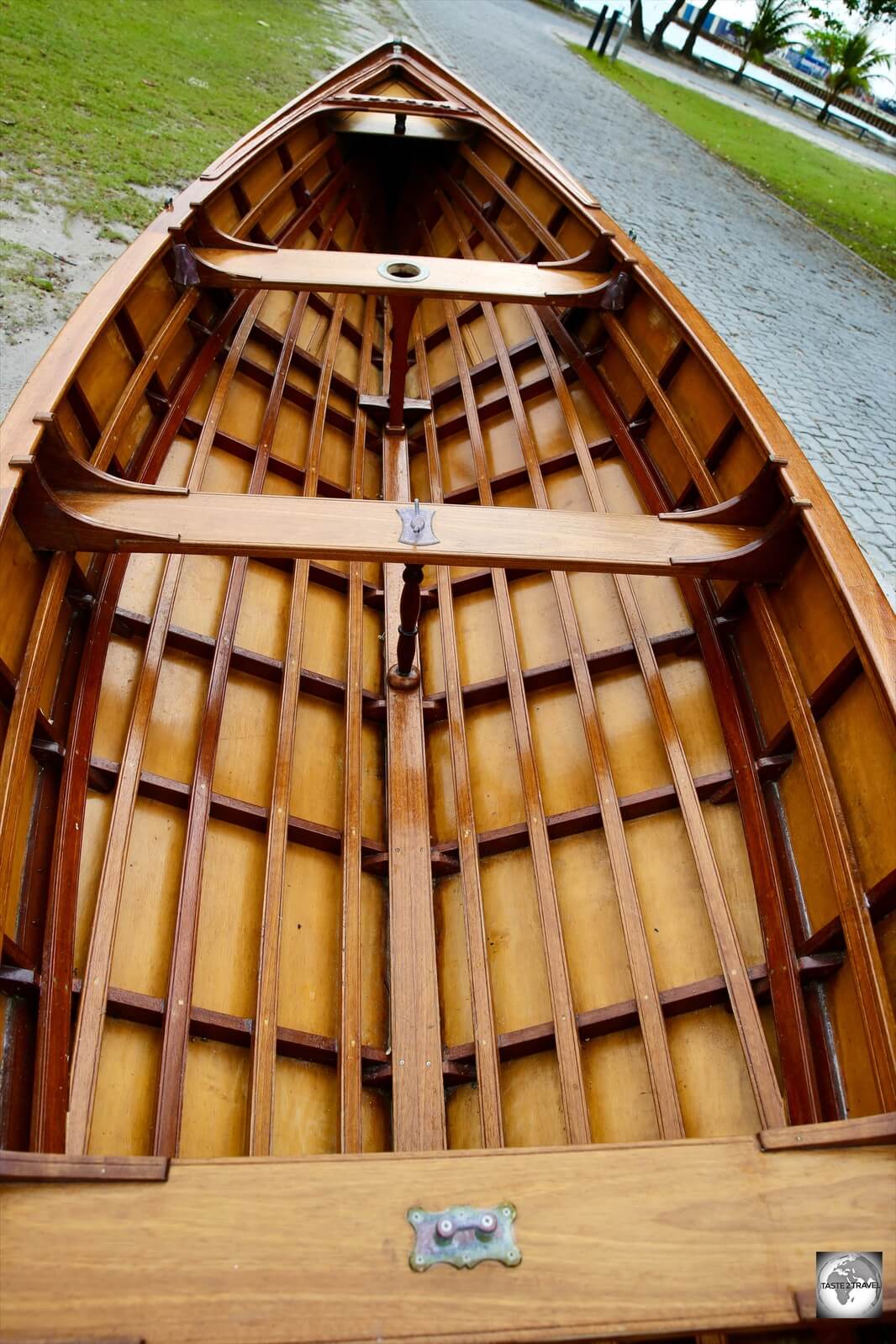
An interior view of a Jukong, which is constructed from local Ironwood.

A Jukong sailing team on Home Island, preparing their boat for the big race.

A very competitive race as the different Jukong teams round one of the buoys.

The Jukong was originally developed to transport coconuts across the shallow waters of the lagoon.
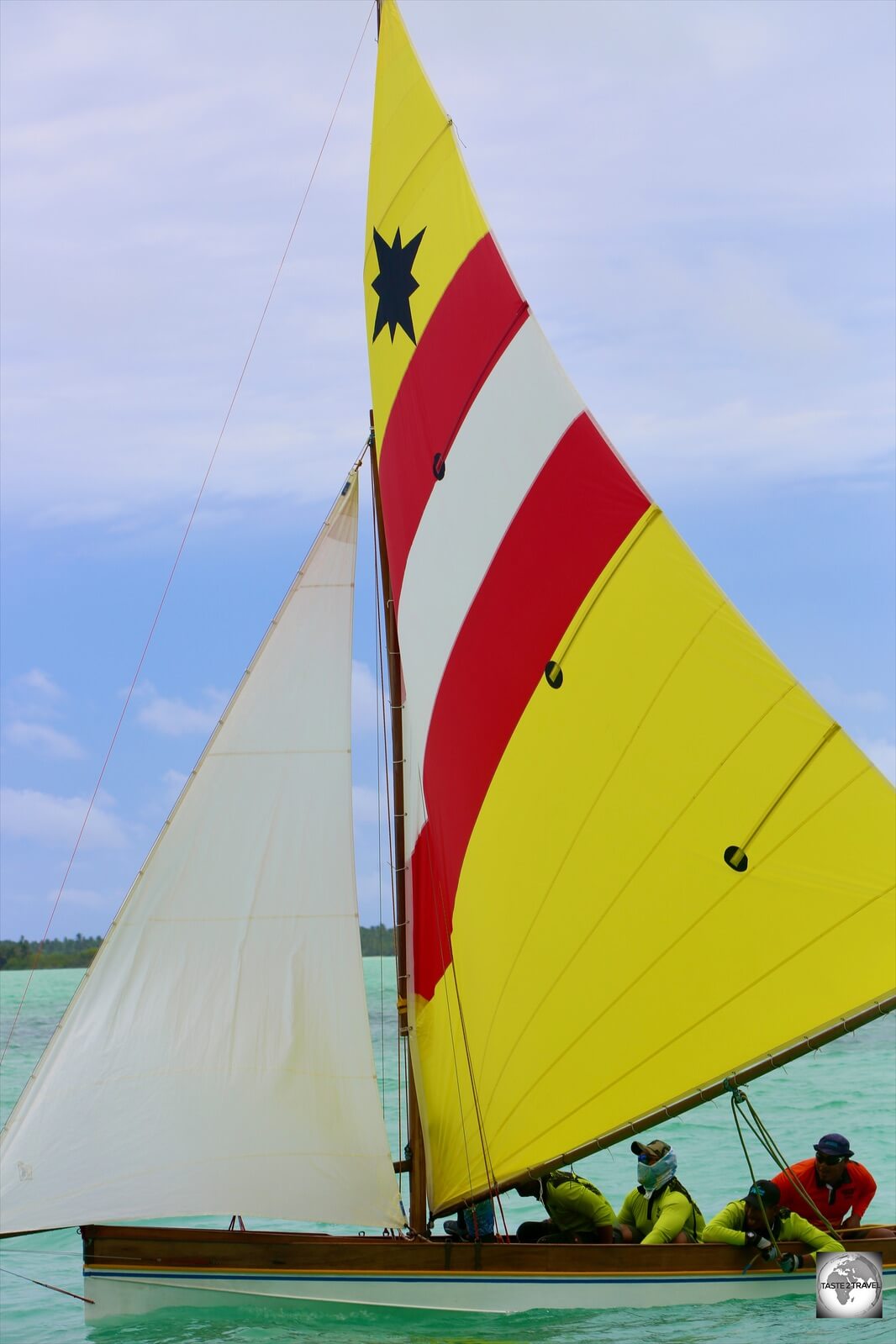
The leading boat in the race.
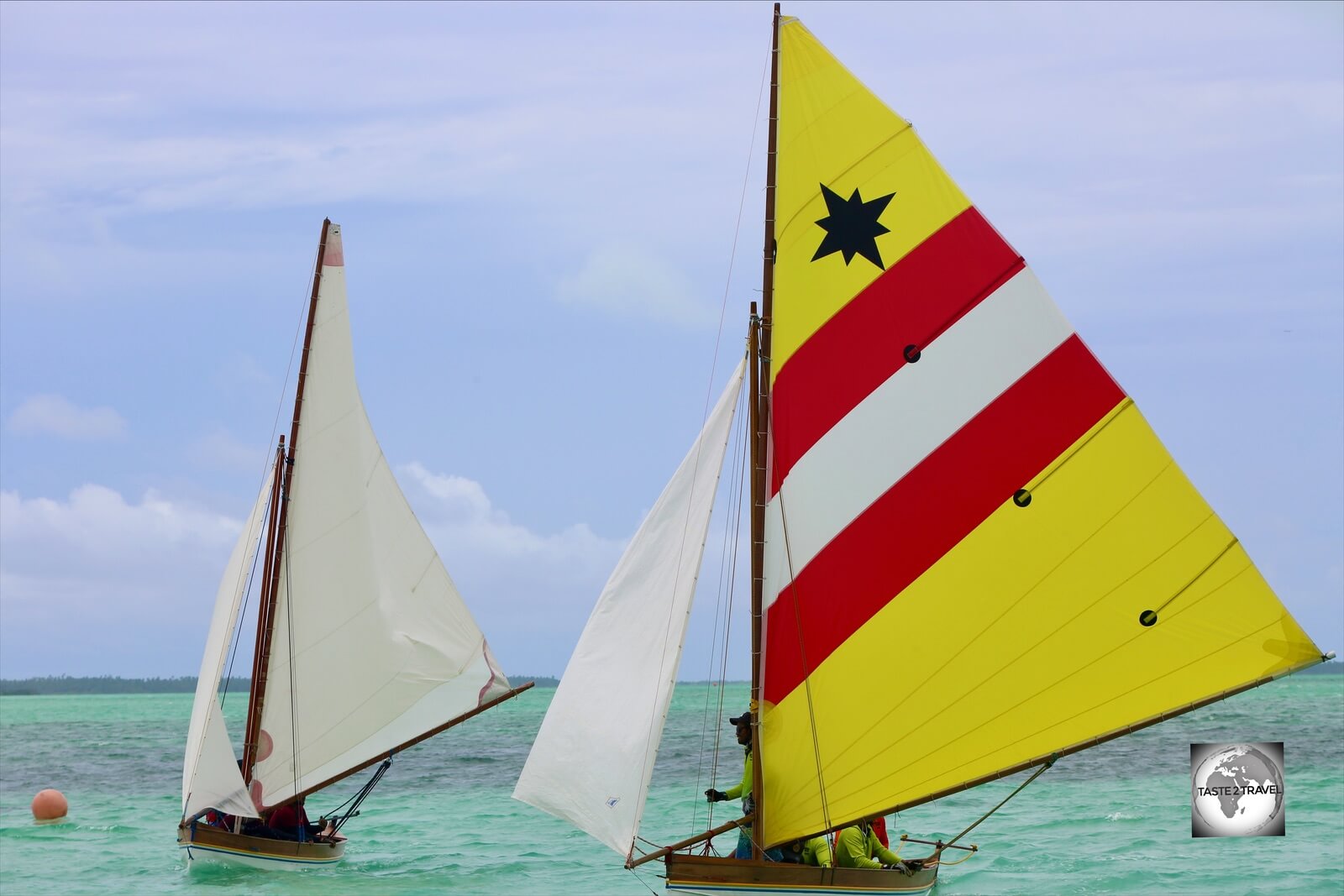
The 1st and 2nd place boats battle it out towards the finish line.

A photo finish between the leading boats.

The crowd gathers to watch the boat race on Home Island.

The winners of the Jukong race.

One unfortunate team managed to capsize their boat after crossing the finish line.
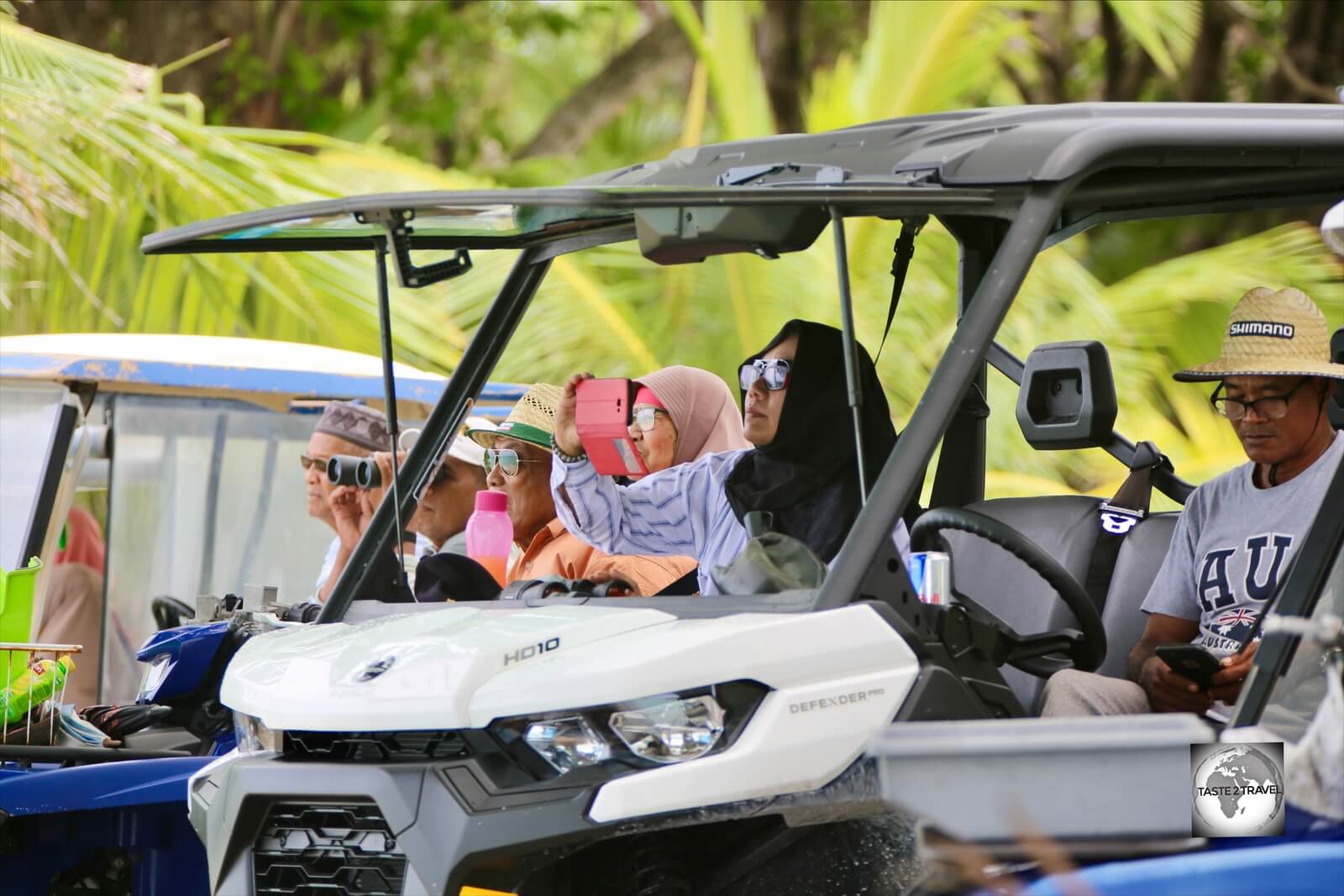
Cocos Malay locals on Home Island, watching the Jukong race from the comfort of their buggies.
Home Island Mosque

The one mosque on Home Island, where 75% of the population are practicing Muslims.
One of the busiest places on Home Island is the mosque, with the call to pray ringing out five times each day. The minaret is painted in the same (Australian) green and gold colours which adorn the territorial flag.

The green and gold minaret of the Home Island mosque.
Home Island WWII Memorial

The Home Island WWII memorial.
During WWII, a single Japanese bomber attacked Direction Island, which was home to a communications station. After the attack, the bomber turned towards Home Island, where it dropped two bombs; one aimed at Oceania House, which landed in the lagoon and one aimed at several houses in the village.
The plane then returned to dump fuel on the house fires which had resulted from the attack. In total 27 houses were destroyed.
Two children died as a result of the attack, with a third person, who was out sailing in his Jukong, never found.
A memorial opposite the ferry jetty is dedicated to those who lost their lives during the attack.
Home Island Cemetery

Graves in the Islamic section of the Home Island cemetery.
Home Island Cemetery is at located at Pulu Gangsa, at the northern tip of Home Island. The land use to be a separate island but is now a peninsula of Home Island.

The grave of Clara Clunies-Ross, in the Christian section of the Home Island cemetery.
The cemetery is divided into two sections; an Islamic and Christian section with almost all the graves in the Christian section belonging to members of the Clunies-Ross family.

A Celtic cross, in the garden at Oceania House, marks the final resting place of many members of the Clunies-Ross family.
The first burial site for the members of the Clunies-Ross family was in the garden at Oceania House, around a large, granite, Celtic cross.

The gravestone for John-Clunies Ross, which is located in the garden at Oceania House.
Home Island Beaches

Offering a wide sweep of sand, Sandy Point is the most beautiful beach on Home Island
There are a couple of fine beaches on Home Island, one of which is located directly in front of Oceania House, while the other is at Sandy Point, which is located near the cemetery at the northern end of the island.

Sunset on Home Island, as seen from the front of Oceania House.
Avril, the owner of Oceania House, told me that when Oceania House was designed, it was laid out on the 4 points of the compass, with the sun setting directly in front of the house each evening.

A view of the lagoon from Sandy Point on Home Island.
Both beaches lie on the west coast of Home Island, offering unrivalled vantage points to watch the spectacular sunsets each evening.

A fiery sunset at Sandy Point, the finest beach on Home Island.
I swam at Sandy Point most days and always had the beach to myself. The sunsets there are amazing!

A view of the lagoon from Home Island.
Watch Tower

The remains of a watchtower on Home Island.
Located on the east coast are the remains of the foundation of an old watchtower which was made from bricks and wood. The tower was equipped with an oil lamp at the top to warn ships at night to stay away from the reef. It was also used as a lookout tower.
Accommodation
Accommodation on Cocos (Keeling) Islands is limited. With the exception of the historic Oceania House on Home Island, all accommodation options are located in West Island, within a short walk of the airport. It’s best to check accommodation availability before you book your flight.
The best place to search and book accommodation is on the Accommodation page of the Cocos (Keeling) Islands Visitor Centre website.
One strange quirk on Cocos (Keeling) Islands is that there are no door keys! I stayed in two different properties and at no stage was I given any keys. There is no crime on the atoll, it’s all wonderfully safe. Locals told me that their homes normally remain unlocked.
West Island

My bungalow at “The Breakers” (formerly Cocos Village Bungalows) on West Island.
The Breakers (formerly Cocos Village Bungalows)
While on West Island, I stayed at The Breakers (formerly Cocos Village Bungalows), which offers large, spacious bungalows, arranged around a well-maintained, tropical garden.

My comfortable room at The Breakers (formerly Cocos Village Bungalows) on West Island.
Located 100 metres from the airport, The Breakers (formerly ‘Cocos Village Bungalows’) feature ten tropical-style bungalows which cost $A240 per night.
With wooden floors and wood paneled walls and ceilings, each bungalow features a large bedroom, kitchen, balcony and bathroom.
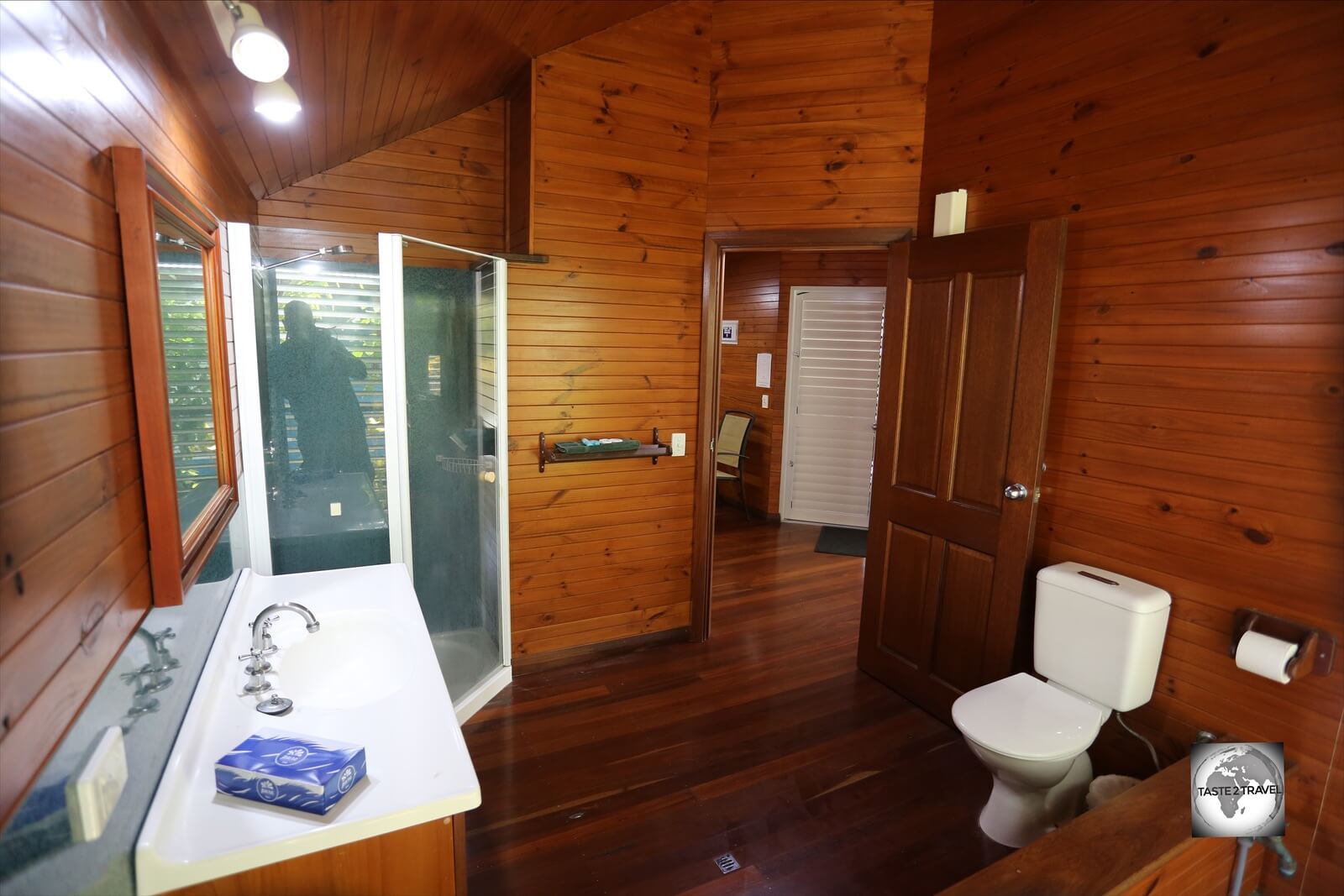
My spacious, airy bathroom at The Breakers (formerly ‘Cocos Village Bungalows’) on West Island.
The Breakers are an ideal accommodation option on West Island.
Home Island
Oceania House

The former residence of the Clunies-Ross family, Oceania House offers a truly memorable accommodation experience.
How often does one have the opportunity to stay as a guest in a house that is of significant historical importance? Oceania House is the heritage-listed, former residence of the Clunies-Ross family, the third home that the family built on their sprawling estate.

Named after the last Clunies-Ross woman to live in Oceania House, the Daphne room was my room during my four-night stay.
Built between 1887 and 1904 using local labour, the house contains four spacious, opulent guest rooms ($250 per night) which are named after members of the Clunies-Ross family – the George, Daphne, Rose and John Sidney rooms.
Oozing with history, Oceania house is a compulsory stay for anyone with an interest in the history and ‘story’ of the Cocos (Keeling) Islands. The triple-glazed, white, bricks which cover the house were imported from Glasgow as ship ballast during the 1880’s.

The vestibule of Oceania house features an antique bishop’s chair.
The house is located on a 5-hectare estate which occupies the south-west corner of Home Island, fronting the beach and lagoon on the south and west sides. Each evening, the sun sets directly in front of the house.

The John Sidney room is named after John Sidney Clunies-Ross who took control of the islands in 1910, after his father’s death.
The actual ground of the estate is covered in about one foot of fertile soil which was imported from Christmas Island. This allowed the family to plant a garden which could otherwise not have grown in the sandy, coral soil that is found elsewhere on the island.

The Rose room is named after Rose Nash, who was married to John Sidney Clunies-Ross.
Oceania House is today owned by a Perth couple, Avril and Lloyd, who have spent years lovingly restoring the house and filling each of the immense rooms with an abundance of antiques.

The dining room at Oceania House.
During my 4-night stay, I was the only guest in this huge, stately home, sharing it with Avril, who is a font of information on the Clunies-Ross family and the history of the Cocos (Keeling) Islands.
Each evening, Avril would relate stories of the family, slowly weaving together the tapestry that is the story of the Cocos (Keeling) Islands.
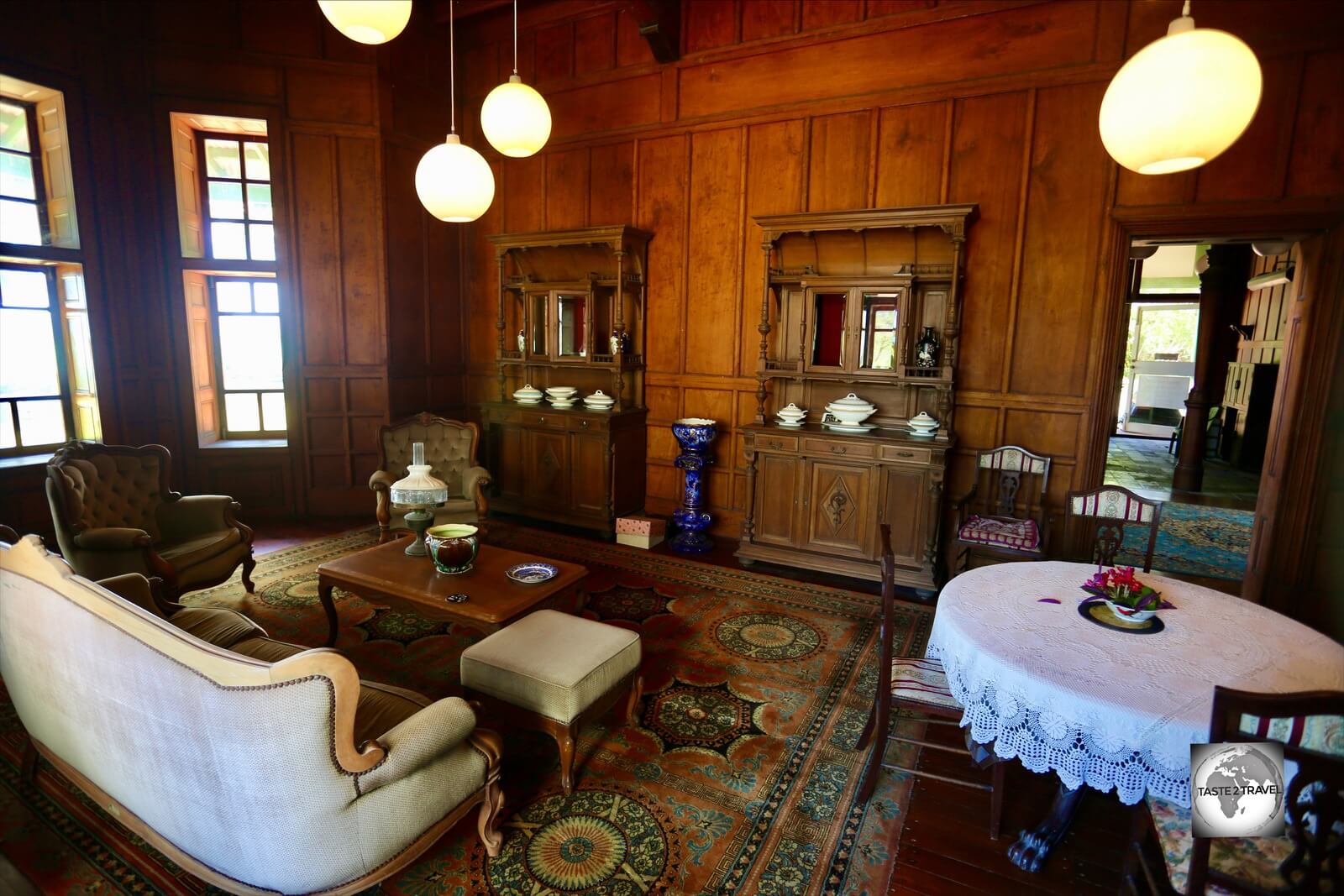
The drawing room at Oceania House.
It is a fascinating history and what better place to learn about it than in the house which the Clunies-Ross once called home. It was a truly remarkable stay and one I cannot recommend highly enough! It was a highlight of my stay on Cocos.

The library at Oceania House.
History for Sale
If you wish to stay at this historical property, then you should do it sooner rather than later! Oceania House is currently for sale, and who knows what the new owner will do with the property.
If you’re an investor and interested in enquiring about the property, you can contact the owners through the Oceania House website.

The staircase at Oceania House which is constructed from Western Australia Jarrah.
Home Island Homestays
Homestays are available on Home Island, and can be arranged through Zulaika at the Island Brunch Cafe.
Eating Out

The Cocos (Keeling) Islands ‘Weekly Dining Guide’ is an indispensable restaurant guide for visitors.
The restaurants and cafes on Cocos (Keeling) Islands keep sporadic opening hours. To avoid any confusion, the Cocos (Keeling) Islands Visitor Centre publishes the very useful Weekly Dining Guide which lists the opening times of restaurants in a handy calendar format.
While there are a total of four dining options on West Island, there are just two options on Home Island.
Restaurants/ Cafés
West Island
Being the main island for tourism, West Island is blessed with exactly four dining options, all of which are open sporadically, and are located a short stroll from each other.
Salty’s Bakery

Salty’s Grill and Bakery, home to the only freshly baked Sourdough on the Cocos (Keeling) Islands.
Housed in the airport terminal building, Salty’s Grill & Bakery is open in the mornings only on flight days (Tuesday and Friday).
From Thursday to Sunday, the restaurant is open from 5 pm to 8 pm with Kebab’s being served on Thursday, Fish and Chips on Friday, Burgers on Saturday and Pizzas on Sunday.
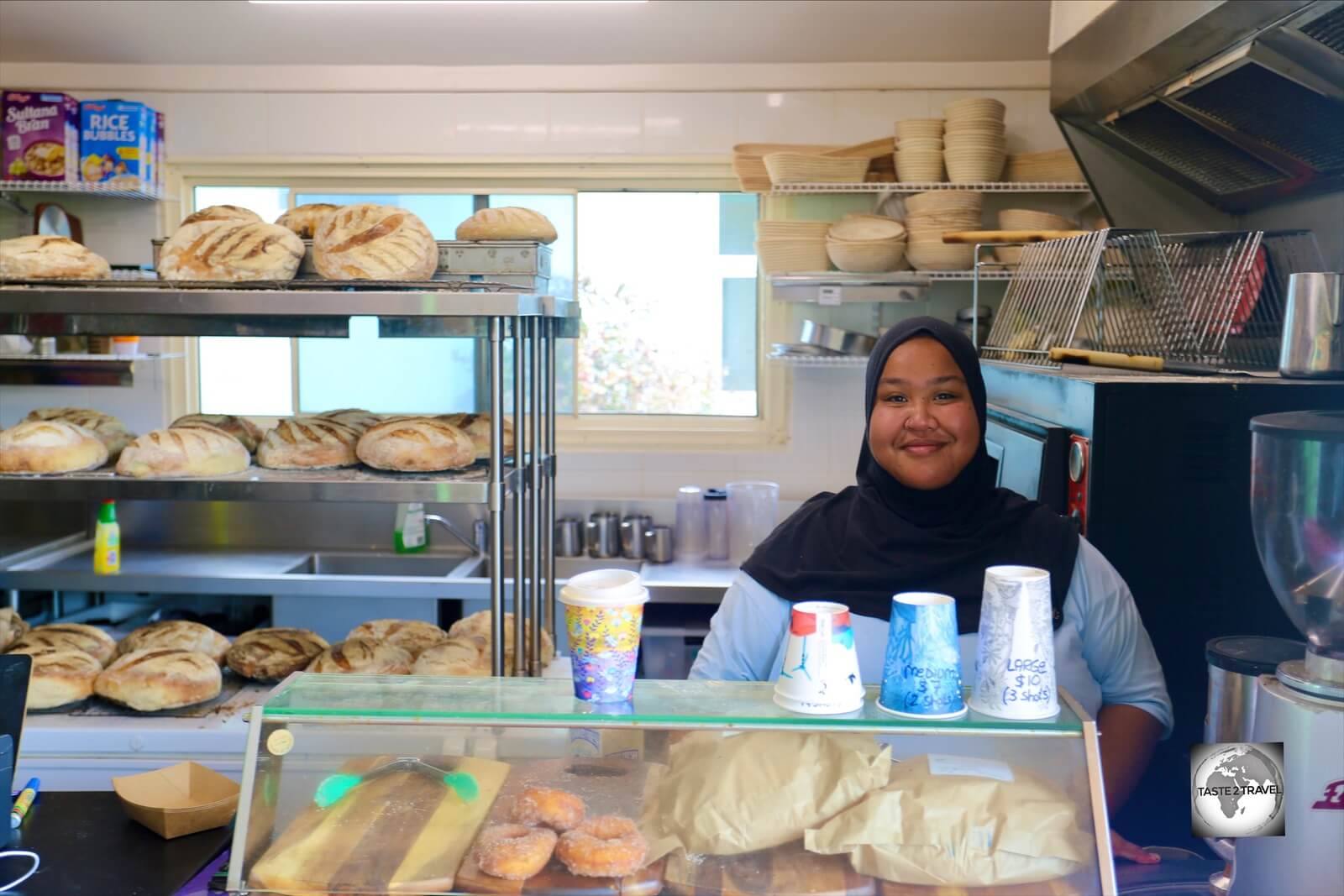
The smiling Barista at Salty’s Grill and Bakery on West Island.
The bakery is known for its freshly baked sourdough bread, the only Sourdough produced on the island, which is available on Fridays. Along with Barista coffee, the bakery also produces some fine pastries, including the best Lemon Meringue tarts on the atoll!
A schedule of Salty’s opening hours can be found on the Cocos Keeling Visitors Centre website.
Saltmakers by the Sea

Dinner at Saltmakers By The Sea, the culinary highlight of the Cocos (Keeling) Islands, shouldn’t be missed.
Located a short stroll from each other, both Saltmakers by the Sea and Salty’s Grill & Bakery are the brainchild of the clearly talented and industrious, Tony Lacey.
Dining under the fairy lights, and stars, at Saltmakers, directly opposite the beach and setting sun, was the dining highlight of the Cocos (Keeling) Islands.
I dined at Saltmakers on the evening of their ‘Coconut Dinner Experience‘, enjoying a two-course meal which featured lots of fresh, local, coconut prepared in a variety of ways.
My main course consisted of freshly steamed, local, lagoon fish, which was served in a creamy coconut sauce with rice and vegetables.
Desert consisted of a warm coconut fondant with homemade coconut and salted caramel ice cream. It was, by far, the best food I tasted on Cocos (Keeling) Islands. This is the one place on the islands from which you can order cocktails, which are divine.
Highly recommended!
A schedule of Saltmakers opening hours can be found on the Cocos Keeling Visitors Centre website.
Tropika Restaurant
The one restaurant on West Island which is open every morning and evening, is the less-than-remarkable Tropika restaurant, which is part of the Cocos Beach Resort. The restaurant and resort are part of the Cocos Islands Co-op.
If you wish to eat dinner at the restaurant (on some evenings this is the only restaurant open), you need to ensure you write your name on the whiteboard, which is located next to the front door, before 4 pm. This allows the staff to cater the correct amount of food, which is served buffet-style from 6 pm to 8 pm.
Dinner consists of a selection of mediocre Malay and Western-style dishes.
Home Island
An important note if you’re staying on Home Island is that neither of the two dining options are open beyond 1 pm, except for the Seafront Restaurant which offers a buffet dinner each Wednesday evening and à la carte dining on Friday evenings.
With no dinner options available, I pre-ordered takeaway meals each morning, which I then reheated in the evening at my accommodation.
Island Brunch Cafe

My ‘go-to’ cafe on Home Island, Island Brunch cafe offers wonderful food, coffee and friendly service.
In terms of dining options, Home Island is a culinary desert! The one oasis is the Island Brunch cafe which is open each day from 8 am to 1 pm.

Iced tea at the Island Brunch cafe on Home Island.
Located next to the post office, the ever-changing blackboard menu includes both Malay and Western options. Whether you’re in the mood for eggs on toast, pancakes, Mie Goreng or Nasi Goreng, you’ll find a good range of appetising meals at the Island Brunch cafe.
During my stay, the island ran out of eggs which reduced the menu somewhat. Eggs are delivered, via air freight from Perth, once every 2 weeks.

The blueberry pancake stack at Island Brunch cafe on Home Island.
While they serve the best coffee on Home Island, the iced-Teh Tarek at Island Brunch cafe is also highly recommended.
The whole operation is under the competent command of the owner, Zulaika, who provides an excellent level of service, ensuring visitors to the island are not left hungry or thirsty.
Seafront Restaurant

The Seafront Restaurant, one of the very few dining options on Home Island.
The one other dining option on Home Island is the Seafront restaurant which is open Monday to Friday until 1 pm.
The restaurant also opens for dinner on Wednesday and Friday nights, with meals served from 6:30 pm to 8 pm. This coincides with the two nights of the week when a late ferry connects Home Island to West Island, with the ferry scheduled to depart Home Island at 8 pm.
Locals raved about the Wednesday night buffet dinner, which I wasn’t able to attend due to the fact that I departed on the Tuesday flight. Reservations, which are essential, can be made from West Island through the friendly staff at the Cocos (Keeling) Visitor Centre.
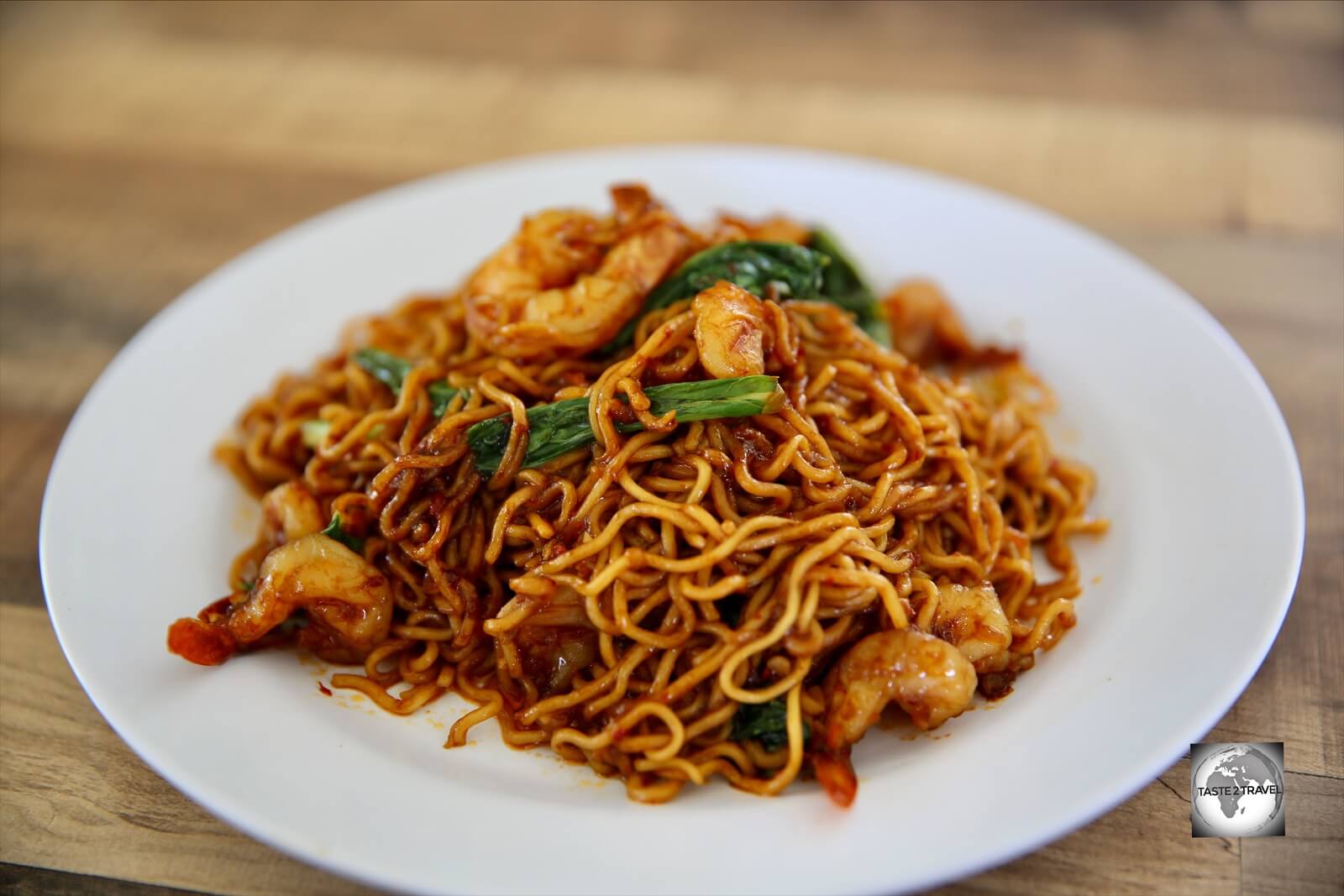
The amazingly tasty, and spicy, shrimp noodles, one of my favourite dishes from the Seafront restaurant on Home Island.
The food served at the Seafront restaurant is very tasty with the deliciously spicy, shrimp noodles, being my favourite dish.
Bars
West Island
Located next to the tiny airport terminal on West Island, the Cocos Club is the only pub/ club on the Cocos (Keeling) Islands. The well-stocked bar serves duty-free alcohol, with most beers costing about $6 a bottle.
The club is open each evening from 5 pm to 10 pm, except on Friday when it remains open until midnight. On flight days (Tuesday and Friday), the bar opens early to cater for airport patrons.
Tuesday night is especially popular with reasonably priced chicken / eggplant Parmigiana dinners drawing the crowds.
Home Island
As the centre for the Cocos Malay (Islamic) community, Home Island is a dry island. Anyone wanting a drink, needs to take the ferry to West Island.
Visa Requirements
Since you can only enter this Australian territory on a domestic flight from Australia, there is no immigration upon arrival at the airport. The entry requirements for Cocos (Keeling) Islands are the same as Australia.
Passengers are required to travel with photo identification such as a passport or drivers’ license, with a passport being the preferred means of documentation. A passport is also much more useful, should your flight be diverted to another country.
To check the visa requirements for Australia, please refer to the Visa Policy of Australia.
Getting There

Virgin Australia operates the only flights to Christmas Island (XCF) and Cocos (Keeling) Islands (CCK) from Perth.
Source: http://www.gcmap.com/
Air

A Virgin Airlines flight arriving on Cocos (Keeling) Islands.
Located on West Island, Cocos (Keeling) Islands airport is the only gateway to the islands. The original runway was built in 1945 by British servicemen to support Allied aircraft in the war against Japan, with bombing raids being conducted against Japanese targets in South-East Asia.
Passenger flights, which are operated by Virgin Australia, arrive twice a week on Tuesday and Friday. The Tuesday flight operates in an anti-clockwise direction, calling first at Christmas Island, then Cocos (Keeling) Islands, before returning to Perth, while the Friday flight operates in the opposite direction.
All of this is subject to change at short notice with everything dependant on the, very unpredictable, tropical weather.

The Cocos (Keeling) airport terminal on West Island.
Flights to the Indian Ocean territories are full of uncertainties. When travelling, you should purchase travel insurance, pack lots of patience, keep an open mind and bear in mind that if something can go wrong, it most probably will!
I spent two weeks visiting Christmas Island and Cocos (Keeling) Islands. It was two weeks of flight cancellations, flight changes and delays.
An added challenge is the distance and flight time involved, with the total flying time for the full circuit being 13 hours, which includes a 40-minute transit on each of the islands, during which all passengers must leave the aircraft.
As per Australian Civil Aviation regulations, during one tour of duty, pilots are able to work a maximum of 8 hours, while cabin crew can work a maximum of 14 hours.
To satisfy these requirements, Virgin carry a 2nd pair of pilots on their flights, allowing 4 pilots to cover the 13-hour flying period. They also carry a mechanic, in case of any mechanical issue, since there are no aircraft mechanics based on the islands. Virgin carries just one flight crew.
In the event of a significant delay, the law requires Virgin to halt the flight so that the crew do not exceed their maximum allowed work hours. This happened on my flight from Christmas Island to Cocos (Keeling), where a technical issue led to a delay which resulted in the flight overnighting on Christmas Island.
The crew arrangement on this flight is very similar to that on the, equally epic, United Airlines’ Island Hopper (UA154), which I covered in my Central Pacific Island Hopper Guide.
Airport Transport
Almost everything on West Island is within walking distance of the airport. If you’re travelling to Home Island, a public bus (50 cents) meets all flights, dropping passengers at the ferry terminal.
The World’s Cheapest Aircraft Carrier

A Dash-8 surveillance plane, operated by Australian Border Force, parked on the runway at Cocos (Keeling) Airport.
The Cocos (Keeling) Islands are located in close to proximity to shipping lanes in the Indian Ocean and hence, is of strategic importance to Australia and its allies, especially the United States.
The island has been described as the world’s cheapest aircraft carrier and serves as a base for Australian surveillance aircraft who conduct regular monitoring flights over the Indian Ocean.
The United States and Australian governments have expressed interest in stationing surveillance drones on the Cocos (Keeling) Islands.
In 2020, the Australian government announced a major upgrade to the runway to support the new P-8A Poseidon Maritime Surveillance and Response aircraft.
Getting Around
Distances on both West Island (6.23 km2/ 2.41 mi2) and Home Island (0.95 km2/ 0.37 mi2) are short, with most things within a leisurely stroll!
Ferry

The Cahaya Baru ferry arriving at Home Island.
The Cahaya Baru ferry links West Island and Home Island every day of the week, except Sundays. On Thursday and Saturday, the ferry diverts to Direction Island, allowing tourists to make daytrips to the island.
The current timetable can be viewed on the ferry page of the Cocos (Keeling) Islands Visitor Centre website.
Public Bus
There is an unmarked, white, public bus (50 cents) on West Island which connects the town with the ferry terminal, leaving town 30 minutes before each ferry departure. The bus does one lap around town, picking up anyone who signals the driver.
Taxi
There are no taxis on Cocos (Keeling) Islands, but the friendly locals will ensure you get to where you’re going. Everything on Home Island is within walking distance, while most things on West Island are a short stroll.
Rental Car

Driving my rental car on the one, main road which runs from the northern to the southern tip of West Island.
West Island
The best place to look for a rental car is on the Car Hire page of the Cocos (Keeling) Islands Visitor Centre website.
While on West Island, I hired a car for 24 hours from Kylie and Ash at Cocos Islands Adventure Tours, which cost me A$80. The one road, which travels the length of the island is about 15-km in length. A few hours are more than ample to explore the island.
The two other rental agents on the island are Cocos Castaway and Cocos Autos Car Hire.
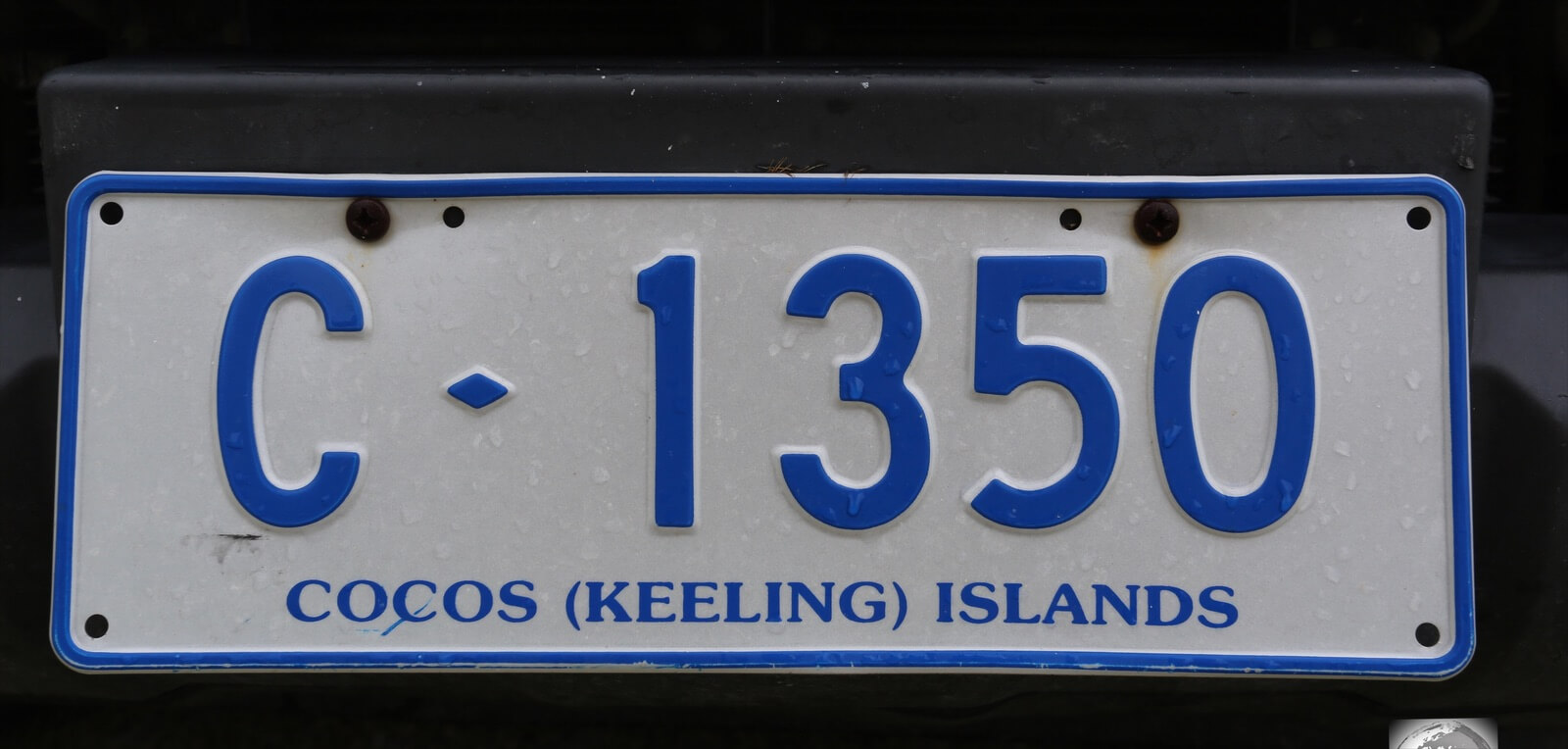
A Cocos (Keeling) Islands license plate.
Home Island
Home Island is very compact and easily covered on foot.
However, if you wish to experience the thrill of the wind rushing through your hair as you cruise along (at less than 30 km/h) in your own buggy, you can rent one through Home Island Hire. The laneways in Bantam village have a maximum speed limit of 8km/h!
That’s the end of my Cocos (Keeling) Islands Travel Guide!
I hope this proves to be useful to anyone planning a trip to this remote atoll, and look forward to hearing from anyone with feedback.
Safe Travels!
Darren
Follow me on Instagram:
[instagram-feed feed=1]
Further Reading
Interested in other Indian Ocean islands? My other guides from the region include:
- Maldives Travel Guide
- Mauritius Travel Guide
- Mayotte Travel Guide
- Reunion Travel Guide
- Seychelles Travel Guide
Cocos Keeling Islands Travel Guide Cocos Keeling Islands Travel Guide Cocos Keeling Islands Travel Guide Cocos Keeling Islands Travel Guide
Cocos Keeling Islands Travel Guide Cocos Keeling Islands Travel Guide Cocos Keeling Islands Travel Guide Cocos Keeling Islands Travel Guide
Cocos Keeling Islands Travel Guide Cocos Keeling Islands Travel Guide Cocos Keeling Islands Travel Guide Cocos Keeling Islands Travel Guide
Cocos Keeling Islands Travel Guide Cocos Keeling Islands Travel Guide Cocos Keeling Islands Travel Guide Cocos Keeling Islands Travel Guide
Cocos Keeling Islands Travel Guide Cocos Keeling Islands Travel Guide Cocos Keeling Islands Travel Guide Cocos Keeling Islands Travel Guide
Author: Darren McLean
Darren McLean is an Australian, full-time, digital nomad who has spent 37 years on a slow meander around the globe, visiting all seven continents, 189/ 193 UN countries and 242/ 251 UN+ countries and territories.
He founded taste2travel to pique one’s curiosity and inspire wanderlust.







